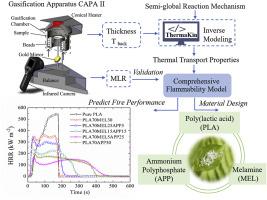Composites Part B: Engineering ( IF 13.1 ) Pub Date : 2020-04-08 , DOI: 10.1016/j.compositesb.2020.108055 Qi Sun , Yan Ding , Stanislav I. Stoliarov , Jinhua Sun , Gaëlle Fontaine , Serge Bourbigot

|
A pyrolysis model capable of predicting materials' fire behavior as a function of concentration was developed for an intumescent flame retardant system: poly(lactic acid) (PLA) blended with melamine (MEL) and ammonium polyphosphate (APP). The model was developed through inverse analysis of data obtained from bench-scale pyrolysis experiments wherein a 0.07-m-diameter disk-shaped sample was exposed to well-defined radiant heating in an anaerobic environment. Sample back surface temperature, sample shape profile and burning rate were measured simultaneously. A numerical pyrolysis modeling framework, ThermaKin2Ds, and a previously developed semi-global thermal decomposition reaction mechanism were employed in the inverse analysis to determine material properties that define the heat and mass transport inside the pyrolyzing solids. The final pyrolysis model was found to predict materials' fire behavior for a variety of thermal exposures and material compositions. The model construction process revealed that a reduction in gas transfer coefficients helped to reproduce certain features of the burning rates profiles. Idealized cone calorimetry scenarios were simulated to study the influence of additives on materials’ fire behavior, and the results demonstrated that the blend with 5 wt% MEL and 25 wt% APP was found to be the most effective system with a 69% reduction in the average heat release rate comparing to that of PLA. A similar significant reduction has been reported in the literature, supporting the accuracy of this model. This work demonstrates a methodology that enables intelligent design of intumescent flame retardant materials tailored for specific applications, where low flammability is required.
中文翻译:

膨胀型阻燃体系热解模型的开发:将聚乳酸与三聚氰胺和聚磷酸铵混合
针对膨胀型阻燃系统,开发了一种能够预测材料的燃烧行为随浓度变化的热解模型:与三聚氰胺(MEL)和聚磷酸铵(APP)混合的聚乳酸(PLA)。该模型是通过对从台式热解实验获得的数据进行逆分析而开发的,其中,直径为0.07-m的盘状样品在厌氧环境中暴露于明确定义的辐射加热下。同时测量样品背面温度,样品形状轮廓和燃烧速率。在逆分析中使用了数值热解建模框架ThermaKin2Ds和先前开发的半全局热分解反应机制,以确定定义热解固体内部热量和质量传递的材料性质。发现最终的热解模型可以预测材料在各种热暴露和材料组成下的着火行为。模型构建过程表明,气体传输系数的降低有助于再现燃烧速率曲线的某些特征。模拟了理想的锥形量热方案,研究了添加剂对材料防火性能的影响,结果表明,含有5 wt%MEL和25 wt%APP的共混物是最有效的体系,其降低了69%。平均热释放率与PLA相比 文献中也报道了类似的显着减少,支持了该模型的准确性。这项工作演示了一种方法,可以针对特定应用量身定制膨胀型阻燃材料的智能设计,



























 京公网安备 11010802027423号
京公网安备 11010802027423号